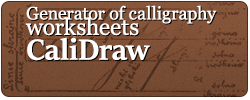Size, spacing and proportions
One of the most important features of a well-calligraphed handwriting is its good proportions. Over time, proportions will be chosen intuitively, but beginners may find this very difficult. The proportions in calligraphy are usually chosen on the basis of the width of the nib with which we are going to write (nib), or more precisely, on the size of the widest line that such a nib can leave. It is therefore good to know the parameters of your accessories.
When you buy a calligraphy set, there should be a leaflet with it indicating the width of the line that the nib gives, given in millimetres. There are also proper names for specific tip widths (as it is with pencil hardness), but these have not been systematised and, depending on the manufacturer, such names can mean quite different things.
If you do not know the width of the tip, nothing is lost – it is relatively easy to measure it. Draw a straight horizontal line on a piece of paper, holding the pen at 90º to the vertical edge of the page (i.e. parallel to its horizontal edge). The thickness of the line is then measured precisely with a ruler or, better, a caliper. The measured value will indicate the width of the nib tip of our pen.
Knowing this width will allow us to create auxiliary lines profiled specifically for our pen. The proportions of the different writing styles vary as does the placement of the helper lines prepared for them. A line sheet can also be generated and then printed using our line sheet tool, CaliDraw.
Calligraphy practice worksheets and their markings

legend:
A – baseline
B – top line
C – slant
D – accent line
E – bottom line (bottom extension line)
F – serif
G – counter
H – nib, a single nib tip width, sometimes a numerical value is given instead of a ladder.
I – ladder of tip width
On the left-hand side above the baseline is a small ‘x‘. There is a path marking which defines the height of the minuscule letters (x-height).
Letters indications
Slightly different symbols can be found on typeface templates. They show in which order and direction to form pen strokes to obtain a given letter. The arrows indicate the direction vector of the pen stroke. The dot represents the beginning and the arrow represents the end of the stroke. The numbers indicate the order in which the strokes should be made.
On the right is an example of the direction and order of strokes for the lowercase letter “k” in italics.




Recent Comments